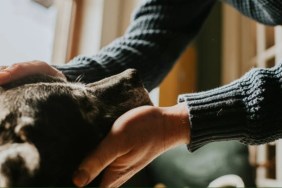
Dago Aceves has just met the dog he wants to bring home. Her name is Maggie and she’s a red-haired Corgi mix who captured his heart from behind bars at the Silicon Valley Humane Society. After they met in the shelter’s greeting pen, he knew she was the one.
But it turns out that new doggie love is kind of like new people love–nerve-wracking. “I hardly slept last night, I was so anxious to see Maggie again,” says Dago, a 25-year-old web developer who lives in Alameda, California. He says it feels like suddenly things are moving very fast.
Maybe that’s because it took so long for him to get here. When he decided to get a dog, he agreed to follow our four-step happy adoption program. He took DogTime’s Are you ready? quiz and found that he was. He answered our Dog Matchup and learned he leaned more toward couch potato than high energy dog. He used our DogFinder to search for adoptable dogs, and trainer Kelly Dunbar, a DogTime contributing editor, helped him zero in on Maggie.
Now all that remains is making sure Maggie gets along with DJ, Dago’s housemate’s dog as per the shelter’s request. So the morning after meeting Maggie, Dago packs DJ into the car and heads an hour south. DJ, an older mutt with the wriggly energy of a puppy, hits it off immediately with Maggie, so the shelter gives Dago the green light to take her home.
Maggie comes home
For the little Corgi mix, it’s an anxious homecoming. The first day, she shows telltale signs of canine stress: she gnaws on her paw, yawns frequently, and refuses to leave Dago’s room. Only chicken jerky strips can induce her to eat, and when she finally takes in some kibble, it’s only because Dago is handfeeding it to her piece by piece. When visitors come by to meet her, she stays shyly glued to Dago’s side. When he’s in the bathroom, Maggie stands watch outside the door, whimpering.
“She’s bonded to me, but for the wrong reason,” says Dago. “It’s because she doesn’t feel safe if she’s not right next to me.”
Anxious times
But that’s nothing compared to the trials of housetraining and crate-training. Following DogTime’s advice on how to handle your first week with a new dog, Dago buys a list of must-have supplies for new owners, including food, collar and leash, and chew toys. He dog proofs his house. He takes a few days off work so he can attend to her housetraining.
He’s also just bought a new crate, considered a critical part of the housetraining process. He introduces Maggie to it on the first day home, and she goes in willingly enough so long as he’s standing nearby. But the moment he walks away, the whining begins.
Keeping in mind Kelly Dunbar’s advice about crate-training, Dago holds firm. He works with her, letting her in and out of the crate over and over again, and making sure she has a chew toy there when he’s gone.
Housetraining hell
Dago also starts Maggie’s housetraining program, watching or confining her when she’s inside, and taking her outside at least six times a day. This gives her plenty of chances to pee or poop in the right place, so he can reward her, thus driving home the idea that eliminating outdoors is a worthwhile effort.
At least that’s how it’s supposed to work. Unfortunately, Maggie isn’t getting the message. She seems determined to never go to the bathroom again. “Last night we stayed out walking the same stretch of block for about an hour,” he says. “She never went.”
When Maggie finally gives in to nature’s call, she manages to slip away from Dago’s watchful eyes and do it inside–first in Dago’s housemate’s room, then the bathroom, then the living room.
Recovering the joy of being dog
In spite of the whining and sleep deprivation–for dog and man both–Dago nonetheless relishes one of the great joys of adoption: watching a good dog find herself again, and start recovering from the trauma of losing home and family.
The first day Dago brings Maggie to work, the resident office dog tries hard to get her to play, but after a quick, half-hearted romp she goes straight back to Dago. Still, it only takes three days before she’s relaxed enough to join in the fun herself. “I had to stop them when they started going through power cords,”says Dago.
About a week into her new life with Dago, she’s already warming up to people–walking up to strangers, tail wagging, and responding to Dago’s coworkers’ calls. Though she continues looking to Dago first to make sure it’s okay.
The perfect dog
She’s also learning how to be a house dog. Where she once charged up the stairs with Dago hanging on behind, half-strangling herself in the process, she now leaves some slack in the leash. She’s getting used to hanging out in her crate and riding in the car. After several days of cleaning up after her, and wondering if she could ever be trained, Dago now relies on her to pee outside his roommate’s bedroom.
Dago and Maggie have become regulars at the neighborhood dog park, where Maggie plays with great enthusiasm, one eye trained as always on Dago. “She’s opening up in a lot of different ways,” he says.
Dago too is weathering the adjustment well, but he expected to. After steeping himself in DogTime’s advice about those first few weeks at home, he knew bringing home a somewhat shy, untrained dog wouldn’t be all nose kisses and snuggles. “None of this came as a big surprise,” he says.
The two of them have fallen into a comfortable rhythm. He’s now taking Maggie to the office every day, and enjoying long walks along the Bay on weekends–just as he’d fantasized he would get a chance to do. And he’s more thrilled with his new dog than ever.
“She’s everything that I wanted to find in a dog,” he says. “She has a long life ahead of her, and I’m sure there’ll be some surprises. But, really, she couldn’t be more perfect.”









